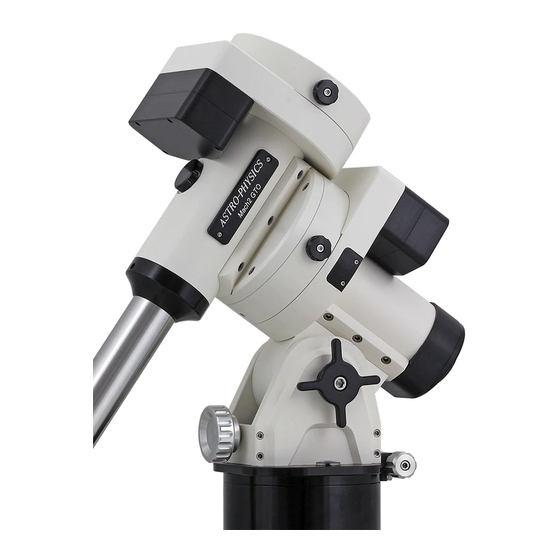ASTRO-PHYSICS 900 German Equatorial Manual - Página 7
Procurar online ou descarregar pdf Manual para Acessórios ASTRO-PHYSICS 900 German Equatorial. ASTRO-PHYSICS 900 German Equatorial 12 páginas. Polar alignment telescope and illuminator (pasill)
Também para ASTRO-PHYSICS 900 German Equatorial: Manual de início rápido (2 páginas), Manual (3 páginas)

REMOVAL
1. Unscrew the lock knobs 5. 5 to 7 full turns (this is still 5/16" to 3/8" out from the fully tightened "shipped" position)
and slide/tilt the Dec. axis assembly in an upwards direction (arrow "B")
2. For transport/storage we recommend fully tightening the lock knobs.
FINE POLAR ALIGNMENT
Follow these instructions if you want to fine-tune the polar alignment of your mount. If not, you may skip this section
and move to Operation of the Mounting.
1. Methods for fine polar alignment:
• Polar alignment telescope – The north celestial pole can be viewed through the polar axis with the optional polar
alignment telescope. Please read the instruction sheets "Polar Alignment Telescope and Illuminator."
• JMI Digital Setting Circles – Please read the instructions included with your JMI unit.
• Star Drift method – This is the most accurate method of polar alignment; however, it is also the most time
consuming. If you are planning long exposure astrophotos, we suggest that you use either the polar axis
telescope or JMI digital setting circles, then tweak the final polar alignment by star drifting. Please refer to the
recommended reading list at the end of this manual for sources that describe the star drift method.
2. Loosen the two altitude locking knobs and four pier knobs and refer back to the section on Altitude and Azimuth
Adjustments – Rough Polar Alignment. Do not loosen the polar axis pivot screws.
3. Follow one of the methods of polar alignment mentioned above.
4. When polar alignment has been achieved, tighten the two altitude locking knobs by hand. Please note that the
polar axis pivot screws should have been tight throughout the fine polar alignment process.
OPERATION OF THE MOUNTING
R.A. and Dec. Damper knobs
The R.A. and Dec. damper knobs are not intended as axis locks. They should be tightened with moderate finger
pressure so that a slight resistance can be felt when pushing an unclutched axis by hand. This really adds to the "feel"
at the end of the scope with the drives adjusted correctly.
R.A. and Dec. Clutch knobs
1. What do they do?
The four R.A. and four Dec. clutch knobs depicted in the diagram on page 2 have the function of connecting the
R.A. and Dec. axes to their respective drive worm wheel gears. Their function is progressive, from no tension (axes
free to move – as required during correct balancing of the telescope) to a completely "locked up" state.
2. How can you find out what they really do?
As shipped, all 900 mounts have all four R.A. and Dec. clutch knobs firmly hand tightened. This will give you a
good idea of the maximum tightness (clutch action) that can be achieved by hand effort alone. At this point, you
must bear in mind that for optimum performance all four clutch knobs on each axis (R.A. or Dec.) should be
tightened evenly with the same tension, i.e., all four half tight, all four fully tight, etc.
In order to feel the effect of the clutch knobs, you may wish to partially assemble your mount. Fit together the R.A.
and Dec. assemblies plus mounting plate and counterweight shaft. Do not put scope and counterweights on at this
stage. With the above assembly (with the clutch knobs firmly hand tightened – "as shipped"), you can feel the
amount of force needed to move each axis by hand. Grab each end of the telescope mounting plate and move it
with a backward and forward movement of the Dec. axis. You will feel considerable resistance to this motion.
Perform the same operation on the R.A. axis by moving the counterweight shaft backwards and forwards. With a
well-balanced telescope, the above tightness of the clutch knobs will be sufficient for all normal conditions of use.
– for astrophotography
- 7 -
